- PIERCED
- 1) In vexillology, a heraldically derived term sometimes used to describe a flag with a plain border
around a plain centre panel – for example a white flag pierced red as shown below (see also
border,
panel and
plain 2)).
- 2) In heraldry the term used when a charge (such as a quatrefoil or mullet) has a hole in its centre
(see also mullet, quatrefoil 2,
star 2) and
voided).
- 3) See transfixed and the note below.
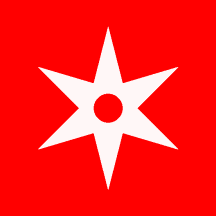
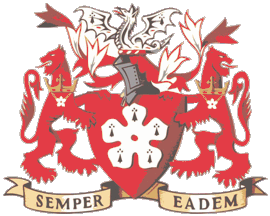
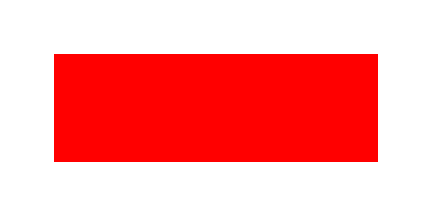
Flag of Font, Switzerland;
Arms of Leicester, UK;
Flag of Ra's al-Khaymah, UAE
Please note that "transfixed" (as referenced above) is the correct heraldic term to use when
a charge is pierced by an arrow or other weapon.

Flag of Euthal, Switzerland
- PIERCED MULLET (or QUATREFOIL etc.)
- In heraldry see ‘rowel’ (also ‘pierced 2)’).

Flag of Bursinel, Switzerland
- PIETY
- See in her piety.
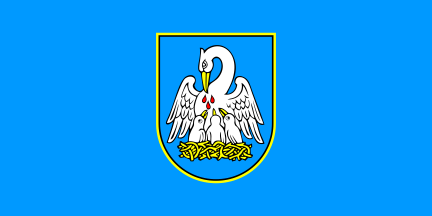
Flag of Sibinj, Croatia
- PIGSTICK
- See ‘truck 2)’.
- PIKE
- 1) In British and some other military usage the staff upon which an infantry
colour is carried (see also 'colour 2)' and
‘colours 2)’
2) See
‘staff 2)’).

"Push of Pike", Battle of Rocroi 1643
Please note that the term is derived from the long-shafted
spear with which a proportion of infantry were formerly armed, and whilst the
term is still applied, the staff may often no longer have a spear point, but may
carry a finial of some other design – see ‘finial’.
- PILE
- 1) On flags, a triangular charge whose base generally occupies the full length
or width of a flag, and whose apex touches the centre of its opposite edge – a
triangle throughout. When
the apex is on the fly it may be called a simple pile, with the apex on the hoist
a reversed pile, with the apex on the top edge an upright pile and with the apex
on the bottom edge of the flag an inverted pile (see also
reversed,
triangle) and
upright).
- 2) In heraldry, an elongated triangular charge which is less than the full
width of a shield or banner of arms (although it is sometimes stipulated that
the pile should be one-third the width of that shield or banner of arms),
is occasionally wavy or embowed and
is generally (although not invariably) placed with the point downwards – but
see per chevron and its following note (also
chapé,
embowed, the note following
per pile,
reversed 2),
triangle 3)
and ‘wavy’).
- 3) On obsolete military colours, one of four triangular charges that narrow from a flag’s
corner towards its centre – wedges – see
‘pile(s) wavy 1)’
(also ‘colour 2)’ and
‘colours 2)’).



Presidential Flag, Namibia;
Flag of Brinches, Portugal;
Flag of Paszowice, Poland
Please note with regard to 1), however, that on
flags a triangular charge whose apex and/or base do not touch opposite edges
of the flag should be considered a triangle – see ‘triangle’.
- PILE EMBOWED (ARCHED or ENARCHED)
- See pile 2) and embowed (also the note following per pile).
![[pile embowed]](../images/v/vxt-d074.gif)
Flag of Oberdorf, Switzerland
- PILE REVERSED (DEBASED, EVERTED, INVERTED, SUBVERTED or SUBVERTANT)
- See pile 2), reversed 2); and
per chevron) with its following note (also
chapé and the note following per pile).
![[pile reversed]](../images/v/vxt-d4264a.gif)
![[pile reversed]](../images/v/vxt-d4264.gif)
Arms and Flag of Špišić Bukovica, Croatia
- PILE(S) WAVY
- 1) On flags, particularly (but not exclusively) obsolete military colours, one or
more wavy edged (that is flame-like) triangles which generally narrow from the corner
or corners towards the centre – a wedge wavy – see ‘pile
3)’ (see also
‘wavy flame’ and
‘flammes 1)’).
- 2) In heraldry, see ‘pile 2)’ and
‘wavy’.
![[pile wavy]](../images/v/vxt-d078a.gif)
![[pile wavy]](../images/v/vxt-d1922.gif)
![[pile wavy]](../images/v/vxt-d4604.gif)
Major's Colour of the Royal Guards 1685, England;
Colour of the 27th Regiment of Foot c1750, Prussia;
Flag of Øyestad, Norway
- PILGRIM'S (or PALMER'S) STAFF
- In particularly (but not exclusively) South European heraldry the walking staff carried by those on a
religious pilgrimage – a palmer's staff (see also baton(s) 3),
escallop and crozier)
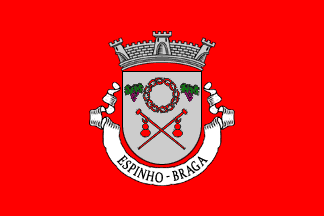

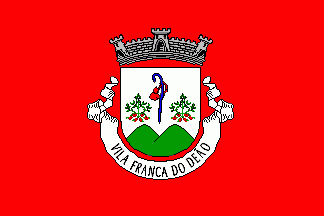
Flag of Espinho, Portugal;
Flag of Glarus canton, Switzerland;
Flag of Vila Franca do Deão, Portugal
- PILGRIMAGE PENNANT (or FLAG)
- A small triangular pennant, or occasionally a handwaver size flag, purchased as the souvenir
of a spiritual (usually Roman Catholic) pilgrimage, religious festival or special place of
worship, and often made from paper (see also ‘handwaver’).
- PILLORY
- A term used in (largely) Iberian heraldic blazoning to describe a stone pillar, and almost invariably
set upon a step or steps – a term, as far as can be discovered, not used in English heraldry.
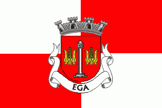
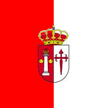

Flag of Ega, Portugal;
Flag of Benquerencia, Spain;
Flag of Paçó, Portugal
- PILOT FLAG
- That flag which is flown by a vessel requiring or carrying a pilot, now
either G for Golf (if requiring a pilot) or H for Hotel (if under pilotage)
from the International Code of Signal Flags (see also
International Code of Signal Flags and
signal flag).


Signal Flag Golf;
Signal Flag Hotel
Please note however, that many countries originally
had their own designs for pilot flags, of which the UK version – that is the national
flag with a white border – is typical of the type and a rare survival – see
pilot jack (also "civil
jack" under jack).
See supplemental note
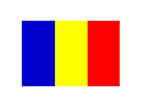
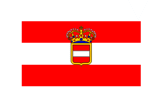
Former Pilot Flag of Romania;
Former Pilot Flag of Austria-Hungary ca. 1890
- PILOT JACK
- In UK usage, the flag introduced in 1823 as the signal for a pilot and replaced
(in that role) c1970 by the ICS flags listed under pilot flag; it is now
considered an alternative term for the British civil jack
(see "civil jack" under
jack,
Marryat’s code,
pilot flag plus its following note and
union jack).
![[a pilot jack]](../images/v/vxt-d245.gif)
![[a pilot jack]](../images/v/vxt-d2585.gif)
UK Pilot Jacks de jure and de facto (fotw & Clay Moss)
Please note that the date upon which this flag began to be flown as a civil
jack is unknown, but possibly as early as the mid-19th Century.
- PINSEL (or PINCEL)
- A triangular pennant used by the authorized representative of a Scottish clan
chief in that person’s absence. It has a solid field and is 0.60 x 1.35 m long,
it is generally charged with the grantee’s crest within an annulet or ring (ensigned
with a coronet or bonnet dependent upon rank), and the grantee’s motto – a pensel or pincel (see also
‘annulet’,
‘ensigned’,
‘guidon 3)’,
'pennon 3)’,
‘ring’,
‘standard 4)’).
![[pinsel]](../images/v/vxt-d1496.gif)
Pinsel of the Clan Fraser (Fraserchief)
- PIPE BANNER
- See ‘bannerette’.
![[pipe banner]](../images/v/vxt-d4087.gif)
Pipe Banner/Bannerette, 7th Duke of Edinburgh’s Own
Gurkha Rifles, UK
- PIPING
- A term for that edging which emphasizes any raised detail on a flag or emblem –
but see ‘raised detail’.
![[a pipe banner]](../images/v/vxt-d2905.gif)
Flag Patch, German c1939 (WarRelics.com)
- PIRATE FLAG
- See 'jolly roger'.
![[pirate flag]](../images/v/vxt-d1076.gif)
Pirate flag
- PLACE OF HONOUR
- 1) On a flag see ‘honour point 1)’.
- 2) Of a flag or coat of arms see ‘position of honour’.
- PLAIN
- 1) See ‘undefaced’.
- 2) On flags, the term that is applied to a flag which has a monocoloured field, or to
a bicolour, tricolour, triband or multi-stripe which carries no charges other than its
stripes, or to an undecorated border or panel consisting of a single colour (see also
‘bicolour 1) & 2)’,
‘border’,
‘charge 1) & 2)’,
‘monocolour’,
‘multi-stripe’,
‘panel’,
‘pierced 1)’,
‘triband 1) & 2)’ and
‘tricolour 1) & 2)’).
- 3) In heraldry the term is sometimes used to describe a simple charge when it is
displayed in the same quarter of a coat of arms with another which is decorated or in
some way altered – for example a plain chevron may be surrounded by an engrailed border
(see also ‘bordure’,
‘charge 1)’,
‘coat of arms 2)’,
‘chevron 1)’,
‘engrailed’,
‘quarter 2)’).
![[plain flag]](../images/v/vxt-d3634.gif)
![[plain flag]](../images/v/vxt-d4069.gif)
![[plain flag]](../images/v/vxt-d4070.gif)
Reserve Ensign, UK;
State Arms of Slovenia;
Civil Flag of El Salvador
- PLAIN CROSS
- A cross whose arms are straight-sided, of equal width and free of any further detailing or decoration
– see cross 1), Greek cross and Latin cross
(also Scandinavian cross).
![[plain cross]](../images/v/vxt-d4143.gif)
![[plain cross]](../images/v/vxt-d4144.gif)
![[plain cross]](../images/v/vxt-d5321.gif)
Flag of the Military Order of Malta;
National Flag of Tonga;
National Flag of Denmark
- PLANTAGENET CROWN
- See ‘antique crown 2)’.
![[Plantagenet crown]](../images/v/vxt-d3604.gif)
Richard ll, King of England 1377–1399 (Wikipedia)
Please note that the Plantagenets were the ruling house of England from 1154–1485 (Henry II –
Richard III).
- PLATES
- A heraldic term for a number of white or silver discs –
roundels argent – but see
quinas (also
bezant,
hurt,
pomme(s), roundel 3) and
torteau).



Flag of Ichtegem, Belgium;
Flag of Portugal 1185; Flag of Koekelare, Belgium
Please note that in strict English heraldic usage this term should only
be employed when the charge described is white/silver (argent) – see tinctures.
- PLOUGH
- In largely (although not entirely) Continental European heraldry, the representation of a traditional agricultural implement – see the note below and
‘ploughshare’.
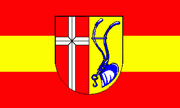


Flag of Kirchlinteln, Germany;
Flag of Faia, Portugal;
Flag of Husum, Germany
Please note that ploughs (or parts thereof) are rare (but not unknown) in English heraldry, and that depictions of the implement may occasionally be seen on flags from non-European countries.

Flag of Guangdong Peasants Association c1925, China
- PLOUGHSHARE (or PLOUGH SHARE)
- In largely (but not entirely) Continental European heraldry a term used for the (variously detailed)
cutting blade of an agricultural implement – a plough share – see plough
(also hafted).
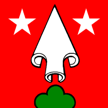


Flag of Rothrist, Switzerland;
Flag of Čađavica, Croatia;
Flag of Wanzwil, Switzerland
- PLOYÉ
- An alternative heraldic term to embowed – see ‘embowed’.

Flag of Fischbach-Göslikon,
Switzerland










![[pile embowed]](../images/v/vxt-d074.gif)
![[pile reversed]](../images/v/vxt-d4264a.gif)
![[pile reversed]](../images/v/vxt-d4264.gif)
![[pile wavy]](../images/v/vxt-d078a.gif)
![[pile wavy]](../images/v/vxt-d1922.gif)
![[pile wavy]](../images/v/vxt-d4604.gif)










![[a pilot jack]](../images/v/vxt-d245.gif)
![[a pilot jack]](../images/v/vxt-d2585.gif)
![[pipe banner]](../images/v/vxt-d4087.gif)
![[plain flag]](../images/v/vxt-d3634.gif)
![[plain flag]](../images/v/vxt-d4069.gif)
![[plain flag]](../images/v/vxt-d4070.gif)
![[plain cross]](../images/v/vxt-d4143.gif)
![[plain cross]](../images/v/vxt-d4144.gif)
![[plain cross]](../images/v/vxt-d5321.gif)
![[Plantagenet crown]](../images/v/vxt-d3604.gif)












![[pinsel]](../images/v/vxt-d1496.gif)
![[a pipe banner]](../images/v/vxt-d2905.gif)
![[pirate flag]](../images/v/vxt-d1076.gif)